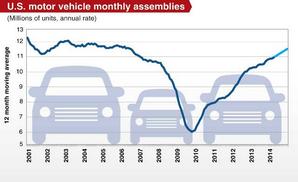Bill Wood
Published: May 12, 2014 12:55 pm ET
Updated: May 12, 2014 1:01 pm ET

Image By: Plastics News
After a few lackluster months this past winter, U.S. demand for new autos has rebounded this spring.
According to data compiled and reported by AutoData Corp., total sales of new cars and light trucks hit a seasonally-adjusted, annualized rate of 16 million units in April. This figure was down a bit from the rate of 16.4 million units posted in March, but it represented a solid gain of 8 percent from the sales total registered in April of last year.
So after a couple of down months in January and February, dealer showrooms bustled in March and April. For the year to date, total light vehicle sales are running 3 percent ahead of the same period in 2013.
This will most surely be welcome news to plastics processors because the plastics industry has relied heavily on the automotive end-market as a source of demand for plastics parts ever since the recession ended.
Our research indicates that during the past four years, the automotive industry (along with the packaging and medical end-markets) has consistently been the highest-ranked in terms of future growth expectations by plastics professionals. And capital spending by the auto sector drives demand for molds, screws, barrels, and auxiliary and primary processing equipment.
For a while last year, it looked like the party might be over because the longer-term trajectory in the sales data flattened out during most of 2013. But we now expect this recent trend of accelerating growth to persist through the end of 2014 and beyond. By the fourth quarter of this year, we expect the data for total vehicle sales will hit or exceed an annualized rate of 17 million units per month. This would represent a rate of growth for all of 2014 in the range of 5 to 6 percent for the year when compared with 2013.
Our forecast is based upon expectations of continued improvement in the U.S. economic conditions that drive demand for big-ticket durable goods such as autos. These include: a steadily improving job market with an accompanying rise in wages; increased activity in the residential construction and real estate sectors; and easing access to financing at low rates of interest.
All of these conditions have improved in recent months, and though there are always downside risks, there is a strong probability that they will continue to improve for at least the remainder of this year and throughout 2015 as well.
A closer look at the sales data reveals a few trends that offer additional insight into the future direction of the auto market and the economy. Through the first four months of 2014, total sales of autos are actually down about 2 percent, while total sales of light trucks — the category that includes SUVs and minivans — are up a robust 8 percent. In terms of total units, cars were outselling light trucks at this time last year, but light trucks have a slight advantage so far this year.
This likely indicates more than just a shift in consumer preferences. Light trucks are often purchased by contractors and other types of small businesses in anticipation of future increases in business activity. The recent surge in the light truck numbers suggests that there has been an increase in fleet sales as delivery vehicles. In other words, capital investment in light trucks is starting to accelerate, and this is an indication of rising confidence in the manufacturing sector and the economy.
Another data series that measures activity levels in the automotive industry, and which plastics processors should scrutinize, is the monthly data on motor vehicle assemblies in the U.S. that is compiled and reported by the Federal Reserve Board. The trend in the sales data described above is an excellent indicator of U.S. demand for light vehicles, but it includes sales of imported cars which are manufactured in another country and are likely to have fewer, if any, U.S.-made plastic parts. The data on motor vehicle assemblies is a measurement of vehicles that are actually assembled in the U.S. This tends to be a better indicator of the trends in demand for domestic suppliers of plastics parts, molds, and tooling.

Image By: Plastics News graphic by Jessica Jordan
As this chart indicates, the number of motor vehicles assembled in the U.S. has been steadily rising since the Great Recession ended in 2009. During the four years from 2010 through 2013, the number of motor vehicles assemblies increased at an average rate of 18 percent per year. So far in 2014, the number of assemblies is up 5.4 percent from the comparable period in 2013. We expect that this rate of growth will prevail through the remainder of the year, and thus our annual forecast calls for an annual gain of 5.5 percent which would put the number of units assembled right at 11.6 million units.
Prior to the recession, the number of assemblies in the U.S. averaged 12 million units per year. It is not likely that we will get back to that level this year, but our preliminary forecast calls for the total number of assemblies to exceed 12 million units in 2015. And unless something changes dramatically in the near term, about two thirds of that total will be assemblies of light trucks and about a third will be autos. The Japanese and German car makers sell more cars than trucks in the U.S. market, but light trucks account for a strong majority of the total assemblies for GM, Ford and Chrysler.
There have been times during the past few years when the monthly totals for auto assemblies were growing faster than the totals for light trucks, but that is not the case at the present time. In fact, the major car company that has enjoyed the sales fastest growth so far in 2014 is Chrysler, and all of its growth has come from its light trucks division (specifically, the Jeep brand). Sales of Chrysler cars are down 20 percent this year, but sales of Chrysler light trucks are up a whopping 30 percent. A similar pattern in the data where the year to date car totals are down while the truck totals are up is also apparent in the data from Ford, Toyota and Honda.
These trends may be an early indicator that Americans are growing less wary of the rising cost of fuel. Or they may be an early indicator that business owners and managers are more confident, and therefore the long overdue upturn in the capital expenditure cycle is finally underway.
But whatever the reason, more vehicles are being built and purchased, and the car companies are more profitable. This will drive more plant expansions, more R&D, and more new model introductions. All of this bodes well for the plastics processors, mold makers, and equipment manufacturers who supply this industry. | 